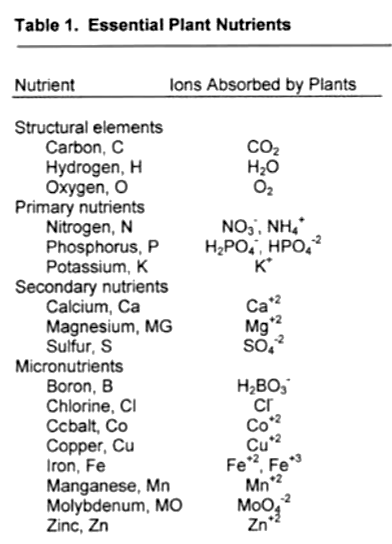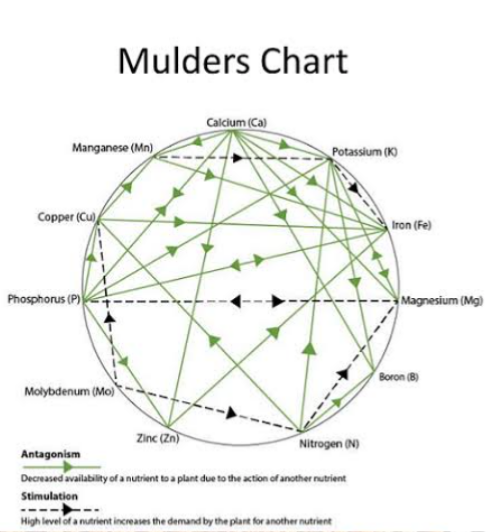The Ultimate goal of the farmer is to obtain high yield of crop from his farming business. The most important limiting factor in crop farming is inadequate nutrient limiting crops yield. But it should also be noted that some of the low yield related to deficiencies or excesses of nutrients are not usually caused by a shortage of the element in question but rather by a poor combination of nutrients with other nutrients,.
Plants uptake two types of nutrients from the soil. The native soil nutrients and the foreign soil nutrients. The native soil nutrients are the nutrients in the soil before fertiliser Application. While the foreign nutrients are the nutrients in the fertilisers applied.
The nutrients required by plants can be grouped into two types
1. Macro or major nutrients
2. Micro, or trace or minor nutrients.
Plants require 16 nutrients for normal growth and for completion of their life cycle. These nutrients (16 nutrients) can further be divided into two groups of nutrients. Mineral nutrients and the non mineral nutrients.
MACRO NUTRIENTS
The macro nutrients required by plants are 9 in number. Three of which are non mineral nutrients and they are carbon, hydrogen and oxygen which are supplied to plants by air and water. The remaining 6 nutrients which are nitrogen (N), phosphorus (P) , potassium (K) , calcium Ca) , magnesium (Mg) and sulphur (S) are mineral nutrients.
MICRO NUTRIENTS:
These nutrients are 7 in number. They are mineral nutrients along side the 6 macro nutrients. They include Boron (Bo) , copper (Cu) , chlorine (Cl) , Iron( Fe) , manganese (Mn) , molybdenum (Mo) and zinc (Zn) .

The growth and development of crops depend on availability and amount of nutrients in the soil. Depleted Soils do result in low yield of crops. Also, Nutrients can have beneficial or detrimental effect on crop yield. Excess of some nutrients do result in reduce uptake by plants atimes while excess of some nutrients do result in uptake of other nutrients to lower or increase yield respectively. This brings about the genesis of nutrient interaction. Nutrient interactions occur when one nutrient influences the uptake and utilization of another nutrient. Nutrients can have beneficial or detrimental interactions with each other as it relates to crop yield. Nutrients interact with one another during uptake or inside the plant.
Therefore, Nutrients interaction is important to be studied so as to optimize yield. Not only do plants interact with soil nutrients, but the nutrients also interact with each other.
SYNERGISTIC NUTRIENT INTERACTION
synergistic nutrient interaction is the interaction between two nutrients which results in an increased yield response that is more than what would be expected of the response to each nutrient INDIVIDUALLY. This mean that in Synergistic interaction, One nutrient increases the availability of another nutrient in the soil, it promotes its uptake into the plant, or it enhances its function in plant metabolism.
Most macronutrients have synergistic responses – for example, N and P or N and K. Because of this synergism, less N can be used when applied with K, and still achieve the same yield. This would benefit both the farmer in cost savings and the environment. Other nutrients and micronutrients have also been shown to have synergistic reactions. In one study, the addition of more zinc (Zn) resulted in a higher yield of wheat in calcareous soil, and the yield increase was largest at the highest addition of macronutrients. However, in acidic soil, the addition of Zn only had an effect on yield if it was already deficient and was not affected by the number of macronutrients.
Phosphorus and zinc
P element is an essential macro-nutrient needed for crop growth and high yield, and processes such as photosynthesis, root formation and nitrogen fixation. Both P and Zn are essential nutrients needed for plant growth. In a research study conducted at Landmark University Teaching and Research farm, Omu-Aran, Nigeria in 2017 and 2018, The result showed that Application of 8 kg Zn ha-1 and 120 kg P ha-1 showed synergistic effect on the vegetative parameters and this was similar to the application of 8 kg Zn ha-1 and 80 kg P ha-1. The interaction of Zn and P also showed synergistic effect on the yield and yield parameters when 8 kg Zn ha-1 and 80 kg P ha-1 were applied to groundnut on an Alfisol soil.
Potassium and magnesium
Magnesium is vital for several plant physiological and biochemical processes, including photosynthesis, carbohydrate partitioning,N metabolism, osmotic balance and protein synthesis, that affect plant growth and yield formation. It is also an activator of more than 300 enzymes. In a study carried out by Kalilius Xie (2020), There was synergistic effects of K and Mg on photosynthesis, carbohydrate transport and allocation, nitrogen metabolism, and turgor regulation. Both Mg2+ and K+ play important roles in maintaining cellular pH balance, and K+, a major osmolyte in vacuoles, is essential for stomatal opening.
Sulphur and Nitrogen:
Sulphur promotes the function of Nitrogen in protein synthesis. Both elements are constituents of proteins and if Sulphur is deficient, protein formation will be limited.
Sulphur increases the efficiency of Nitrogen fertilization, as Sulphur is needed for nitrate reduction. In case of Sulphur deficiency, nitrate will accumulate inside the plant and growth will be depressed.
Manganese and Nitrogen:
Manganese promotes the efficiency of Nitrogen in protein synthesis, as it is a constituent or activator of involved enzymes and thus needed for protein formation.
Calcium and Boron:
Boron and Calcium are both constituents of cell walls. They support cell wall and cell membrane stability as well as functionality and thus promote fruit quality.
Calcium and Boron both promote cell elongation to increase fruit size.
The combination of Calcium with Boron is known to inhibit the formation of the plant growth substance ethylene. Low ethylene levels will lead to increased fruit set or less pod abortion in soybeans.
Phosphorus and Boron:
Phosphorus and Boron are promoting root growth.
Boron enhances pollen tube germination and thus fruit set. Phosphorus is also needed for flower formation and fruit set.
Zinc and calcium
In a study, addition of more zinc (Zn) resulted in a higher yield of wheat in calcareous soil and the yield increase was largest at the addition of micronutrients.
Mulder’s Chart
Mulder’s chart clearly explain nutrient interactions and how the nutrient interaction affect plants based on soil pH.
To maintain healthy uniform plant growth, optimal soil pH range must be maintained . soil nutrients are absorbed by plant roots in the form of cations and anions. These nutrients dissolve in water to form ions and they attach themselves to water molecules ( H+ and OH-) after which they are absorbed by the plant root and translocate to other parts of the plant. Plants thrive best at soil pH between 6.0 and 7.0, when all the essential elements are best absorbed by the plant.
What is Mulder’s Chart?
Mulder’s Chart shows the interaction between the 11 essential elements that are needed for plant growth. There are two types of reactions, synergistic and antagonistic reactions.
A synergistic interaction refers to a relationship whereby one element aids the uptake of another as stated by Mulder.
How To read Mulder’s Chart?
The chart below shows how nutrients interact with one another. For example, high levels of iron in the soil will result in the plant needing additional potassium. Also, increased nitrogen levels create a demand for more magnesium at optimum pH level etc. With this in mind, it is possible to correct deficiencies by altering the quantity of macro and microelements in the soil.

The Law of the Minimum
In the 19th century, the German scientist Justus von Liebig formulated the “Law of the Minimum,” which states that if one of the essential plant nutrients is deficient, plant growth will be poor even when all other essential nutrients are abundant.
He stated that when the price of fertilisers are high, growers tend to reduce or even eliminate applications of micronutrient or secondary nutrient fertilizers which result in low or reduced yield of crops.
Liebig emphasised on the negative effect of Lowering inputs — such as cutting back on fertilizer rates which can lead to lower yields and profits. While Optimising fertility helps ensure maximum economic yield.
An example of the Law of the Minimum is shown in a study where K and Mg where used to determine the effect on potato yield and nutrient content of potato leaves. When Mg was deficient in the soil where potato was planted, there was absolutely no yield response to added potash, because Mg deficiency depressed yields. But as both nutrients were applied together, yields increased.
Another example is in a study in which a soil is very deficient in S, the application of N alone produced no yield increase in barley production. Conversely , applying S alone was also largely ineffective without N on barley yield. But When both nutrients were applied together, high yield was Obtained. This offer another clear example that the Law of the Minimum works. Therefore, a farmer who purchased N only — and left out S to “save” some money — would be disappointed with the low yield result from his farm especially if the price of the N is high, he would achieve a great loss.
In conclusion, crop farmers need the knowledge of synagism to be able to identify the reasons for reduction in crop yield so as to proffer solution to their problems.
